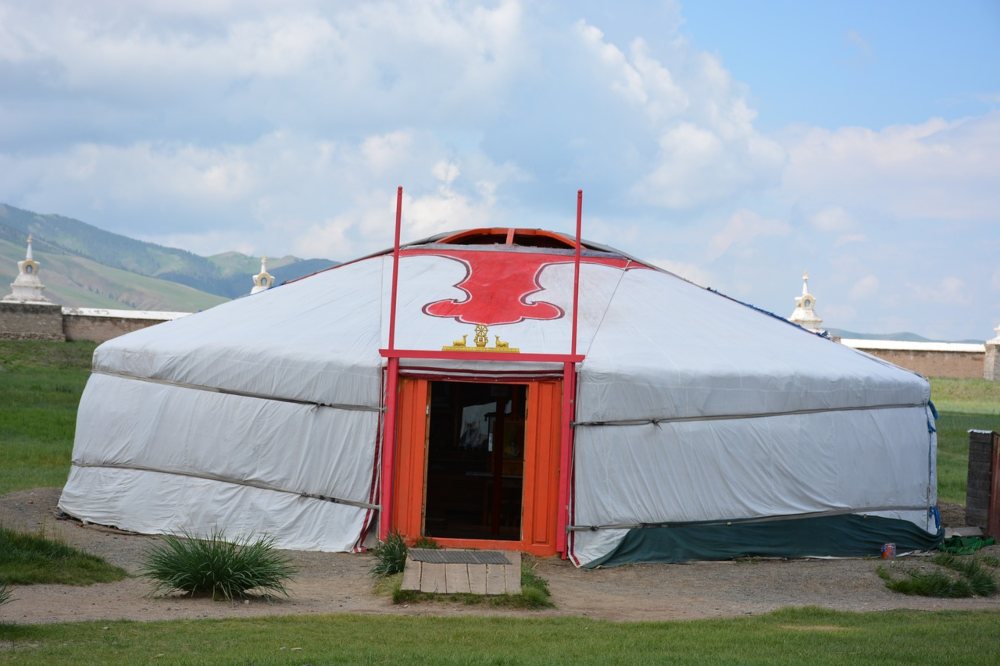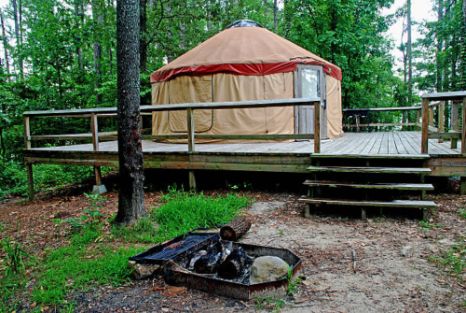A yurt looks like either a small, round tent or something similar in design but made out of wood frames instead of fabric walls. They are known to have originated in Central Asia, but they can now be found everywhere from Mongolia to Alaska. The word “yurt” comes from the Turkic verb meaning “to dwell.” Yurts come in many shapes and sizes depending on their intended use, but most of them are built using wood or bamboo poles covered with felt or tarps made out of animal skins. Many modern yurts are also insulated with wool carpets and padded furniture inside.
Yurts are made up of a wooden latticework that is circular and has walls that attach with leather straps, the roof covering attaches to central beams using ropes and heavy stones placed on top for stability. They can be easily erected or disassembled with some basic tools allowing their owners to move them on a regular basis if required by the nomadic lifestyle that is still practiced today.
The inner frame consists of pieces that are not very tall and therefore more flexible to make it easier for transportation and less likely to be damaged during bad weather conditions such as strong winds or storms.
The roof of the yurt is normally supported by two or three larch poles that reach from the top to the bottom at each end. Smaller wooden beams connect these poles at around mid-height through T crosspieces, giving extra support to the structure. The rafters are tied with ropes or ribbons made of wool. The structure is covered with hand-stitched felt which, most often, has a smoke hole at the top.
The roof is covered with felt and traditionally was also used as a place to store animals that could be brought into the yurt for warmth during cold winter nights.
They usually have a door and a smoke hole for ventilation.
The yurt can be decorated with many different things like rugs, hangings (like tapestries), or other decorations that express the personality of its owner. The floor may be covered by carpets and skins for decoration as well as comfort while sitting on a small bench which is often placed along the wall.
Modern vs Traditional Yurts
Traditional Yurts

Traditional Mongolian yurts are constructed of woven lattice structures held together with flexible poles that are bound and draped in fabric, or a similar material. The roof (crown) has a tent-like appearance after completion. In ancient times, smoke was allowed to waft out of the yurt without dampening the fire within by covering the
Traditional Yurt Lattice:
The lattice-like walls of a yurt are typically divided into easily transportable modules, known as khana. The light wood is tied together with leather or animal hair twine and crisscrossed in a trellis to collapse down into a khana. When the yurt is built, the khana is put upright on an eight-foot circular base that resembles a saucer. The khana is then held together with more latticework, which is covered in fabric or felt to provide insulation from the cold ground and wind.
Traditional Yurt Roof:
The yurt’s roof is the most challenging component. The crown, often known as the tono, is a central ring that sits atop two upright ornamental support posts known as bagana. Around the crown, the roof support poles, or beams, known as uni are connected in the form of sunbeams following setup.
The interior of a yurt may have crowns, which are made of reed or fabric. Crowns, unlike the rest of the yurt, are passed down from generation to generation.
Yurt Crown (Tono) & Support Poles (Uni)
In traditional yurts, the crown aperture (tono) allows the stove chimney to pass through in the winter and for air to circulate in the summer. In the summer, when no additional heat is required from the stove, food is cooked outside.
The most basic coverage for yurts used to be four or five layers of felt, with an outer layer of canvas, or any other waterproof fabric, on top. Traditional yurts are well suited for life in the vast grasslands because they may withstand winds of up to 10 mph and winter temperatures that reach -19°F.
Large yurts, which were used by chieftains and prominent persons, were split into many different rooms. Large traditional yurts may even have a second floor or loft, known as a cupola, near the crown. Traditional yurt construction was officially recognized as an Intangible Cultural Heritage by UNESCO in 2013.
Modern Yurts

Modern yurts are becoming increasingly popular in North America and Europe, having first been brought to the United States by yurt pioneer William Coperthwaite in the 1960s. After reading about them in a February 1962 issue of National Geographic magazine, he was inspired to build his own!
Pacific Yurts was founded in 1978, becoming the first yurt business in North America.
The Eastern method of placing everything at floor level rather than the Western technique of raising everything to waist height is what adds to the appeal of smaller yurts.
This functionality was originally intended to make the heating of a yurt easier, but it may add wonderfully horizontal lines to a contemporary, larger yurt.
What Do Modern Yurts Look Like?
Individual modern yurts are built to be permanent on top of a platform, thus the inside and outside of each yurt will vary depending on whether it is a temporary, moveable yurt or a permanent building. The fundamentals of construction, nevertheless, remain the same.
There is the option of customizing one’s yurt, for instance, covering your yurt with more high-tech materials, such as breathable, thermo-fabric, or aircraft cables for a stronger framework construction, is an option. If you’re vegan or vegetarian, this is something to bear in mind because felt is made of wool.
Modern yurts often feature a roof that is self-supporting, although larger yurts may have interior posts that support the crown. A tension band runs along the top of the circular wall in self-supporting yurts to keep them from expanding. The force applied on it by the roof ribs/beams counteracts this.
Modern yurts are a lot bigger and offer more space than traditional yurts.
Source pics:-https://barefootdetour.com/yurt-life/
Source pics: https://www.homestratosphere.com/types-of-deck-chairs/
https://www.homestratosphere.com/types-of-deck-chairs/
Or Amazon
